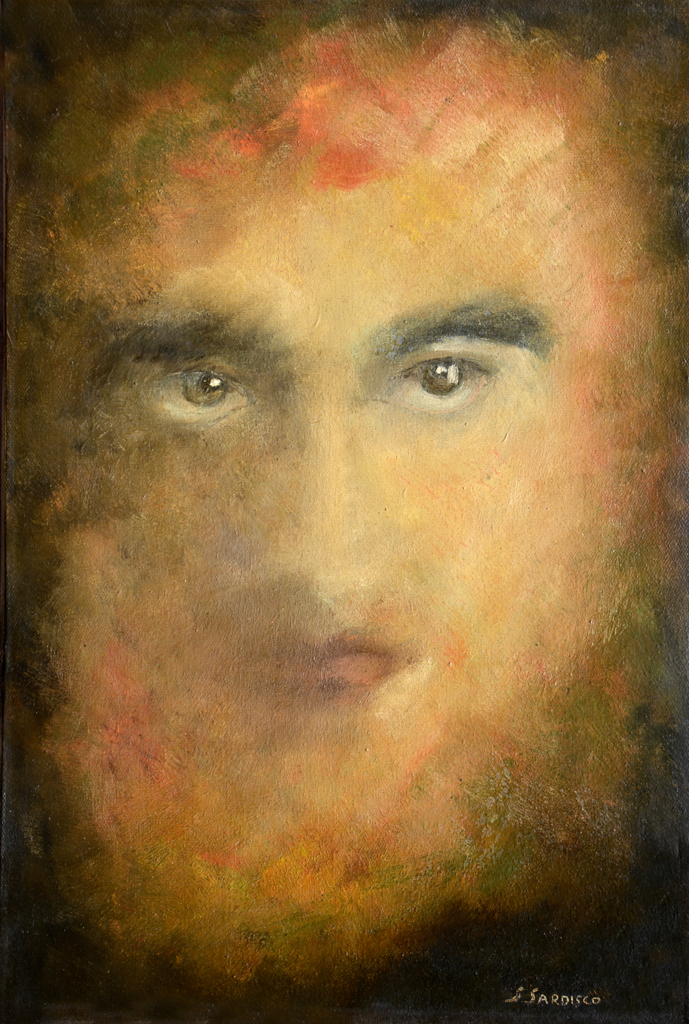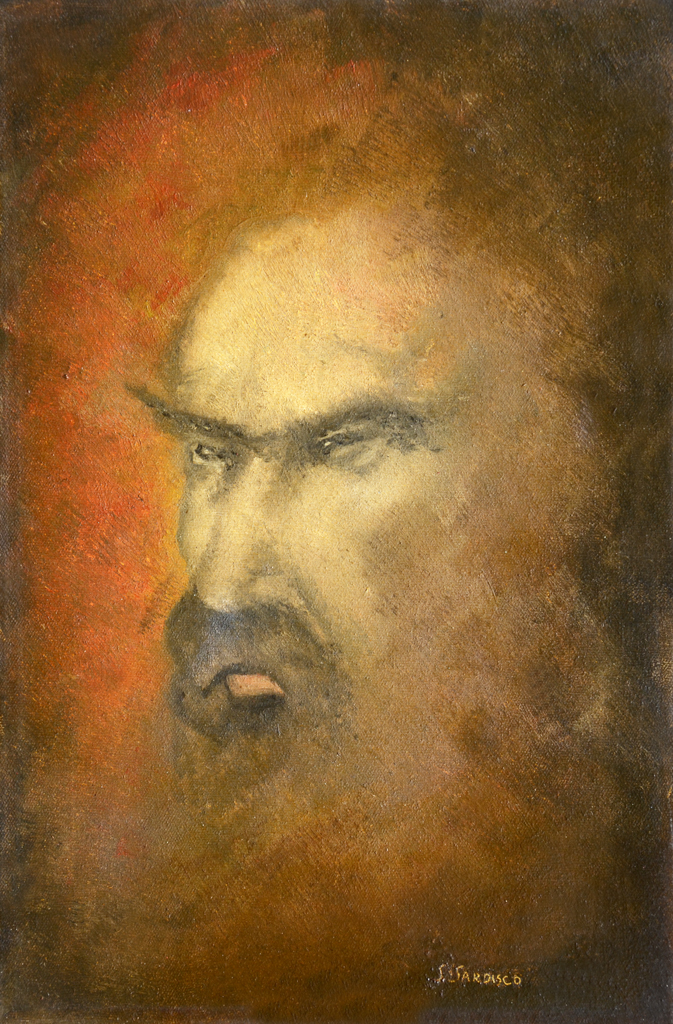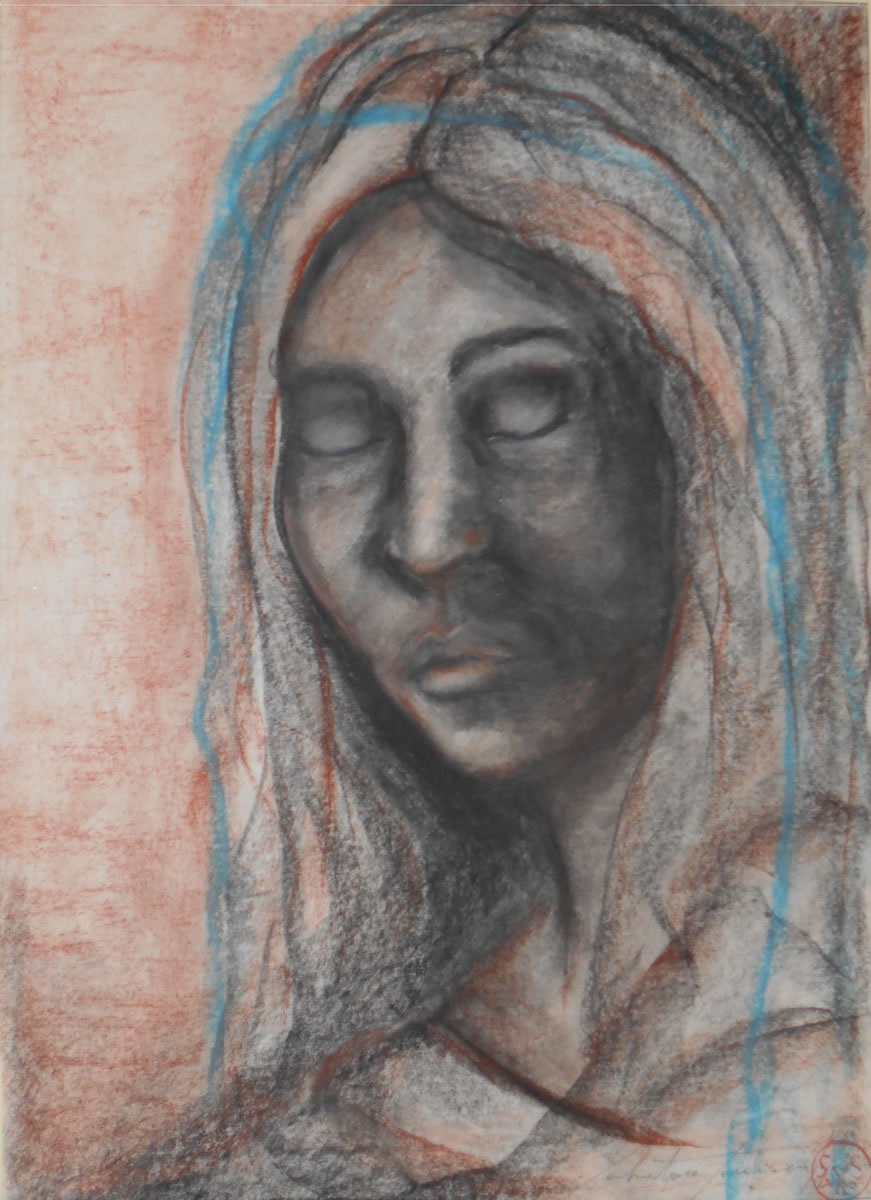16
Il Compiacimento
1972, 30 x 40 olio su tela
Gli occhi e la bocca restituiscono l’intima soddisfazione di chi si riconosce in un’opera o in un’azione compiuta, al punto di rimanerne come orgoglioso.
The eyes and the mouth gives the intimate satisfaction of who is recognizing in an opera or in a finished action, so that remaining proud of it.
16
 Verità esoterica
Verità esoterica
1970, 32.5 x 48 carboncino su carta
Opera di chiaro intento esoterico con una limpida e allegorica rappresentazione delle energie interiori (chakra). Il messaggio indica, al contempo, la necessità di un controllo dei punti vitali per arrivare all’intuitiva illuminazione, alla contemplazione dell’Universo nella sua interezza. Di straordinaria intensità esplicativa il dettaglio degli “occhi”, fonti inesauribili di energia.
Picture of clear, esoteric intent with a well-defined and allegorical representation of the internal energies (chakra) . The message shows the necessity of a control of the vital points to reach the intuitive illumination, the contemplation of the Universe in its entirety. The detail of the “eyes”, inexhaustible sources of energy, has an extraordinary intensity.
12

Crepuscolo della vita
1978, 50 x 60 olio su tela
L’immagine è potente e michelangiolesca nella sua plasticità.
L’uomo di età matura è raffigurato nudo con uno sguardo pensieroso e meditabondo sul senso della vita e della propria esistenza.
In realtà la forza espressiva dell’opera è tale che l’atteggiamento indica, universalizzandolo, il sentimento proprio dell’umanità intera al termine dell’esistenza, quel ripiegare su noi stessi e chiederci se abbiamo vissuto dignitosamente sui sentieri del Bene oppure no.
Dubbi amletici che sembrano rimandare al senso della vita, dell’universo, dello spazio.
Da qui la decisa impronta metafisica che l’uomo acquista, raffigurato nei tratti anatomici essenziali, con un pianeta celeste che pare osservare ed accompagnare impassibile le vicende umane, come l’occhio della verità ultima.
Piccoli cespugli di fiori semplici raffigurano l’essenza profonda di ciò che ci circonda e ci fa gioire intimamente: la bellezza delle cose, e metafisicamente anche delle opere semplici che, sole, ci riscattano dall’inadeguatezza difronte alla Verità e al Divino e che l’uomo pare accarezzare.
All’orizzonte in lontananza “una linea” che, nell’immensità dell’Universo e nella profondità dell’infinito, crea e diffonde un chiarore di luce mentre un tramonto accompagna con i suoi colori un sentimento nuovo di speranza.
Verità o lusinga e inganno?
The image in powerful in its plasticity. The man of mature age is represented naked with thoughful look on the sense of the life and his own existence. The expressive strenght is such an attitude points out, universalizing it, the feeling proper of the whole humanity at the end of the existence that to refold on ourselves and to ask us if we have dignifiedly lived on the paths of the Good, or not. Doubtful that seems to postpone the sense of life, of universe and of space. The man increases a metaphysic marks represented in the essential anatomical lines with a celestial planet that impassive seems to observe and to accompany the human stories. like an eye of a definitive truth. Doubts that seems to refer the sense of life, of universe, of space.
Small bushes of simple flowers represent the deep essence which surrounds, which bring joy intimately: the beauty of the things and of the simple opera that redeem us from the inadequacy in front of the Truth and the Divine One.
A line is at the horizonhat, in the immensity of the universe and in the depth of the infinity; it’s creates and it spreads a light while a sunset brings a new feeling of hope.
Truth or promise and illusion?
04
 Madonna col Bambino
Madonna col Bambino
1980, 30 x 40 olio su tela
Opera del Maestro ventenne che si inserisce a pieno titolo nel solco delle rappresentazioni religiose mariane. Ricorda per molti aspetti il Masaccio, il superamento della rappresentazione iconoclastica nella semplicità e umiltà terrena di chi, con dolcezza materna, si prende cura e premura affettuosa del Suo bambino.
Da notare il moto ondoso e sabbioso sullo sfondo, che crea come un senso di reale movimento alla scena, nella quale si colloca l’immagine. Questa risalta ancor più nell’uso eccezionale del colore ad olio sanguigno che ci restituisce il calore dell’amore materno, l’amore intenso e protettivo della madre per il figlio, il quale nell’abbandonarsi nelle sue braccia, volge al contempo il suo sguardo “altrove”, come a preannunciare la sua particolare e personale missione verso l’umanità.
Un quadro essenziale, lineare come solo i grandi pittori sanno “costruire” con il pennello e dove, infine, la regalità e la purezza divina traspaiono sia dal disegno dei corpi, sia dall’oro di cui sono “rivestiti” prendendo forma. Umano e divino ancora una volta coesistono nell’atemporalità del disegno e nella temporalità della materializzazione del mistero materno e, insieme, filiale.
Sardisco painted this opera at twenty years. It’s inserted in the furrow of the religious representations. Our Lady remembers for many aspects Masaccio’s style. The overcoming of the iconoclastic representation in the simplicity and terrestrial humility of who takes care of her child, with maternal sweetness.
The wavy and sandy motion on bakground creates as a real movement to the scene, in which the image places. The exceptional use of the blood-re color give us the heat of a maternal love, the intense and protective love of the mother for her child, which turns eyes elsewhere. The Child gives advance notice of his personal mission toward the humanity.
04
Autoritratto
1973, 30 x 45 olio su tela
L’opera è stata realizzata cercando in uno specchio il proprio volto. È negli occhi che si può vedere la verità e l’anima per riscoprire l’identità persa: chi sono? Cosa vado cercando? È negli occhi che l’artista ritrova se stesso, assapora la vita in tutte le sue forme e manifestazioni, esce dalla solitudine dell’anima, riesce a conoscersi.
Autoritratto è un’opera enigmatica che meglio ci aiuta a comprendere l’umanità di Sardisco: il suo affacciarsi al significato di tutto ciò che lo circonda, sguardo senza tempo alla ricerca di un perchè.
This painting has been realized looking for his own face in a mirror. In the eyes you can see the truth and the soul for rediscovering the lost identity: who am I? What I’m looling for? In the eyes the artist finds again himself, he tastes the life in all forms and demonstrations. He goes out of the loneliness of the soul, he’s able to identify himself.
This is an enigmantic painting that helps us to understand the humanity of Sardisco: his ability to preapare the meaning of all that surrounds him; his looking without time in the research of a reason.
04
Il Peso del passato
1972, 30 x 40 olio su tela
L’uomo è come “sommerso” nei pensieri e dal fardello della propria vita, in un ripensare che è come fare i conti con la propria esistenza, cercando di scrutarvi un senso, un significato, la ragione ultima di una tensione “amletica” che stavolta, insieme allo sguardo, sono le labbra a indicarci.
The man is surrounded by his thoughts and by a weary life, reflecting and reconsidering his own existence, perceiveing a sense and a meaning; searching for the last reason of an amletic tension showing by lips and look together.
04
 Il Saggio
Il Saggio
1972, 30 x 40 olio su tela
LL Sapienza si accompagna al desiderio, allo sforzo medesimo di vedere, capire e comprendere. Ancora una volta lo “sguardo” è assoluta purezza espressiva.
The knowledge is with the desire, with the effort to see, to understand and to comprehend. The look at the reality is an absolute expressive purity, once again.
04
Madonna Nera
2014, 32.5 x 48, carboncino su carta
L’immagine della Madonna è toccante, rimane scolpita nella memoria per la capacità di emozionare e stupire nella sua straordinaria rappresentazione: una donna semplice, quasi dimessa, come lo è una che viene dal popolo. L’umiltà e l’umanità che si sprigiona, cosi’ viva e intimamente raccolta, è colta in un atteggiamento non iconografico o disteso, ma con gli occhi chiusi in una preghiera che è, al contempo, meditazione e consapevolezza delle eterne sofferenze umane. Una Madonna nera che non è raffigurata nei colori dell’Occidente, ma dei continenti piu’ poveri che conoscono la fame e la sete…
Di tradizionale rimangono solo leggere striature azzurrine, ma insieme a quelle sanguigne, che ci restituiscono la contemporaneità di una Madonna insanguinata dagli odi fra i popoli; in particolare, saremmo indotti a dire, in quel Medio Oriente che costituisce la sua patria terrena.
Ancora una volta, accompagnata e incarnata da maestria e tecnica inconfondibile, emerge anche in questa opera, nella Madre di tutti, la Weltanchauung, la visione del mondo di StYluS, rivolta agli ultimi e agli oppressi della Terra, in un recupero dei valori evangelici più profondi, lontano da una serenità artefatta e vicino alle tristi e dolorose vicende umane…
Madonna’s moving immage is graven in the memory for persuading ability in this extraordinary representation: a simple woman, almost low, as one who comes from the people. The vivid humility and the humanity that is given off, are captured in an attitude with closed eyes, in a prayer that is meditation and awareness of the eternal human sufferings. A black Madonna that is represented in the colors of the poorest continents that know the hunger and the thirst.
Only the blue striations as traditional iconography but with those blood striations that give us the contemporaneity of a bloody Madonna by the hate among the people. We would be induced to say, particularly, in that Middle East that constitutes her terrestrial country. The Weltanschauung emerges also in this painting, in the Mother of everybody once more united and embodied by the skill and by an unmistakable technical. The vision of the world of StYluS: an attention on the last and on the oppressed ones of the Earth, recovering the deeper evangelical value, away from an artificial serenity and next to the sad and painful human stories…
09
 Speranza
Speranza
1972, 30 x 40 olio su tela
Gli olii su tela dedicati agli Indiani: un soggetto di per sé indicativo dell’appartenenza, simpatia e vicinanza del Nostro al mondo dei più deboli, degli accerchiati dalla vita, degli sconfitti. Ancora una volta si fa sentire il peso che ha su StYluS l’esperienza di vita vissuta… Il tema ha qui due varianti. L’una è la speranza colta nella sua intensità e quasi trepidazione, apprensione: una speranza sofferta eppure limpida e innocente come è negli ultimi.
The oil paintings on canvan are dedicated to the Indians: an indicative subject of the affiliation, the affection and the proximity to the wikest world, to the surrounded by the life and of the loser. Once more it makes him feel the weight that has on StYluS the experience of lived life… The theme has two variations: the hope with it’s intensity and almost trepidation, apprehension: a suffered hope but clear and innocent like in the last man in the society.





